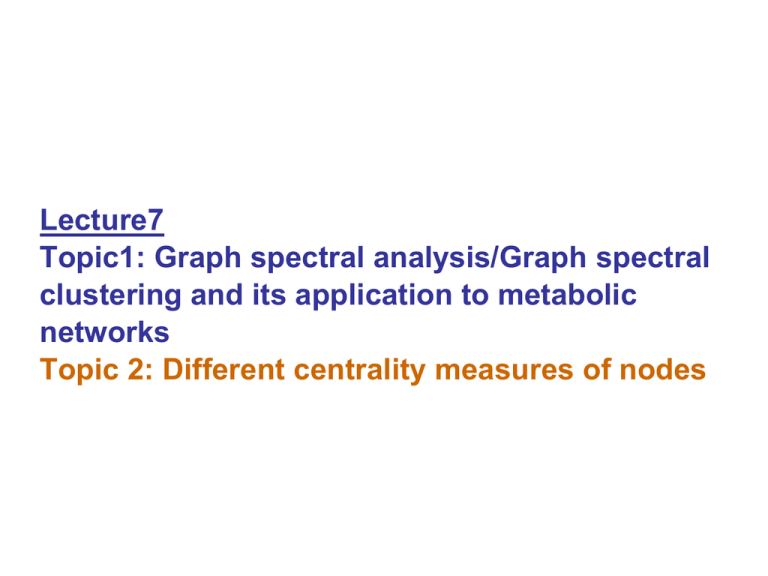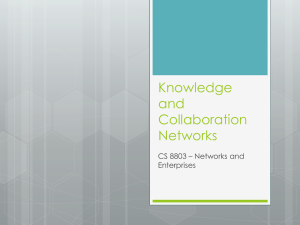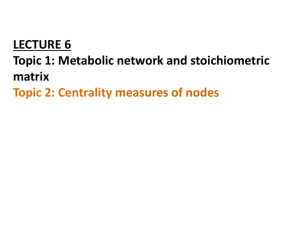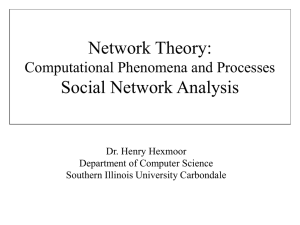Lecture 7
advertisement

Lecture7 Topic1: Graph spectral analysis/Graph spectral clustering and its application to metabolic networks Topic 2: Different centrality measures of nodes Graph spectral analysis/ Graph spectral clustering PROTEIN STRUCTURE: INSIGHTS FROM GRAPH THEORY by SARASWATHI VISHVESHWARA, K. V. BRINDA and N. KANNANy Molecular Biophysics Unit, Indian Institute of Science Bangalore 560012, India Adjacency Matrix Laplacian matrix L=D-A Degree Matrix Eigenvalues and eigenvectors Eigenvalues of a matrix A are the roots of the following equation |A-λI|=0, where I is an identity matrix Let λ is an eigenvalue of A and x is a vector such that -----(1) N×N N×1 N×1 then x is an eigenvector of A corresponding to λ . Node 1 has 3 edges, nodes 2, 3 and 4 have 2 edges each and node 5 has only one edge. The magnitude of the vector components of the largest eigenvalue of the Adjacency matrix reflects this observation. Node 1 has 3 edges, nodes 2, 3 and 4 have 2 edges each and node 5 has only one edge. Also the magnitude of the vector components of the largest eigenvalue of the Laplacian matrix reflects this observation. The largest eigenvalue (lev) depends upon the highest degree in the graph. For any k regular graph G (a graph with k degree on all the vertices), the eigenvalue with the largest absolute value is k. A corollary to this theorem is that the lev of a clique of n vertices is n − 1. In a general connected graph, the lev is always less than or equal to (≤ ) to the largest degree in the graph. In a graph with n vertices, the absolute value of lev decreases as the degree of vertices decreases. The lev of a clique with 11 vertices is 10 and that of a linear chain with 11 vertices is 1.932 a linear chain with 11 vertices In graphs 5(a)-5(e), the highest degree is 6. In graphs 5(f)-5(i), the highest degree is 5, 4, 3 and 2 respectively. It can be noticed that the lev is generally higher if the graph contains vertices of high degree. The lev decreases gradually from the graph with highest degree 6 to the one with highest degree 2. In case of graphs 5(a)-5(e), where there is one common vertex with degree 6 (highest degree) and the degrees of the other vertices are different (less than 6 in all cases) i.e. the lev also depends on the degree of the vertices adjoining the highest degree vertex. This paper combines graph 4(a) and graph 4(b) and constructs a Laplacian matrix with edge weights (1/dij ), where dij is the distance between vertices i and j. The distances between the vertices of graph 4(a) and graph 4(b) are considered to be very large (say 100) and thus the matrix elements corresponding to a vertex from graph 4(a) and the other from graph 4(b) is considered to have a very small value of 0.01. The Laplacian matrix of 8 vertices thus considered is diagonalized and their eigenvalues and corresponding vector components are given in Table 3. The vector components corresponding to the second smallest eigenvalue contains the desired information about clustering, where the cluster forming residues have identical values. In Fig. 4, nodes 1-5 form a cluster (cluster 1) and 6-8 form another cluster (cluster 2). Metabolome Based Reaction Graphs of M. tuberculosis and M. leprae: A Comparative Network Analysis by Ketki D. Verkhedkar1, Karthik Raman2, Nagasuma R. Chandra2, Saraswathi Vishveshwara1* 1 Molecular Biophysics Unit, Indian Institute of Science, Bangalore, India, 2 Bioinformatics Centre, Supercomputer Education and Research Centre, Indian Institute of Science, Bangalore, India PLoS ONE | www.plosone.org September 2007 | Issue 9 | e881 Construction of network Stoichrometric matrix Following this method the networks of metabolic reactions corresponding to 3 organisms were constructed R1 R2 R3 R4 Analysis of network parameters Giant component of the reaction network of e.coli Giant components of the reaction networks of M. tuberculosis and M. leprae Analyses of sub-clusters in the giant component Graph spectral analysis was performed to detect subclusters of reactions in the giant component. To obtain the eigenvalue spectra of the graph, the adjacency matrix of the graph is converted to a Laplacian matrix (L), by the equation: L=D-A where D, the degree matrix of the graph, is a diagonal matrix in which the ith element on the diagonal is equal to the number of connections that the ith node makes in the graph. It is observed that reactions belonging to fatty acid biosynthesis and the FAS-II cycle of the mycolic acid pathway in M. tuberculosis form distinct, tightly connected sub-clusters. Identification of hubs in the reaction networks In biological networks, the hubs are thought to be functionally important and phylogenetically oldest. The largest vector component of the highest eigenvalue of the Laplacian matrix of the graph corresponds to the node with high degree as well as low eccentricity. Two parameters, degree and eccentricity, are involved in the identification of graph spectral (GS) hubs. Identification of hubs in the reaction networks Alternatively, hubs can be ranked based on their connectivity alone (degree hubs). It was observed that the top 50 degree hubs in the reaction networks of the three organisms comprised reactions involving the metabolite L-glutamate as well as reactions involving pyruvate. However, the top 50 GS hubs of M. tuberculosis and M. leprae exclusively comprised reactions involving L-glutamate while the top GS hubs in E. coli only consisted of reactions involving pyruvate. The difference in the degree and GS hubs suggests that the most highly connected reactions are not necessarily the most central reactions in the metabolome of the organism Centrality measures of nodes Centrality measures Within graph theory and network analysis, there are various measures of the centrality of a vertex within a graph that determine the relative importance of a vertex within the graph. We will discuss on the following centrality measures: •Degree centrality •Betweenness centrality •Closeness centrality •Eigenvector centrality •Subgraph centrality Degree centrality Degree centrality is defined as the number of links incident upon a node i.e. the number of degree of the node Degree centrality is often interpreted in terms of the immediate risk of the node for catching whatever is flowing through the network (such as a virus, or some information). Degree centrality of the blue nodes are higher Betweenness centrality The vertex betweenness centrality BC(v) of a vertex v is defined as follows: Here σuw is the total number of shortest paths between node u and w and σuw(v) is number of shortest paths between node u and w that pass node v Vertices that occur on many shortest paths between other vertices have higher betweenness than those that do not. Betweenness centrality σuw a c d b f e Betweenness centrality of node c=6 Betweenness centrality of node a=0 σuw(v) σuw/σuw(v) (a,b) 1 0 0 (a,d) 1 1 1 (a,e) 1 1 1 (a,f) 1 1 1 (b,d) 1 1 1 (b,e) 1 1 1 (b,f) 1 1 1 (d,e) 1 0 0 (d,f) 1 0 0 (e,f) 1 0 0 Calculation for node c Betweenness centrality •Nodes of high betweenness centrality are important for transport. •If they are blocked, transport becomes less efficient and on the other hand if their capacity is improved transport becomes more efficient. •Using a similar concept edge betweenness is calculated. Hue (from red=0 to blue=max) shows the node betweenness. http://en.wikipedia.org/wiki/Between ness_centrality#betweenness Closeness centrality The farness of a vortex is the sum of the shortest-path distance from the vertex to any other vertex in the graph. The reciprocal of farness is the closeness centrality (CC). 1 CC (v) d ( v, t ) t V \ v Here, d(v,t) is the shortest distance between vertex v and vertex t Closeness centrality can be viewed as the efficiency of a vertex in spreading information to all other vertices Eigenvector centrality Let A is the adjacency matrix of a graph and λ is the largest eigenvalue of A and x is the corresponding eigenvector then -----(1) N×N N×1 |A-λI|=0, where I is an identity matrix N×1 The ith component of the eigenvector x then gives the eigenvector centrality score of the ith node in the network. From (1) xi 1 N A j 1 i, j xj •Therefore, for any node, the eigenvector centrality score be proportional to the sum of the scores of all nodes which are connected to it. •Consequently, a node has high value of EC either if it is connected to many other nodes or if it is connected to others that themselves have high EC Subgraph centrality the number of closed walks of length k starting and ending on vertex i in the network is given by the local spectral moments μ k (i), which are simply defined as the ith diagonal entry of the kth power of the adjacency matrix, A: Subgraph Centrality in Complex Networks, Physical Review E 71, 056103(2005) Closed walks can be trivial or nontrivial and are directly related to the subgraphs of the network. Subgraph centrality 01000000000000 10110100000000 01011100000000 01101101000000 00110100000000 01111010000000 M= 00000100001000 00010000100000 Muv = 1 if there is an edge between nodes u and v and 0 otherwise. 00000001010011 00000000101011 00000010010000 00000000000010 00000000110101 00000000110010 Adjacency matrix Subgraph centrality 10110100000000 04223211000000 12432311000000 12352310100000 03223211000000 12332501001000 M2 = 01111020010000 01101102010011 (M2)uv for uv represents the number of common neighbor of the nodes u and v. 00010000421122 local spectral moment 00000000110101 00000011240122 00000100102011 00000001221042 00000001221123 Subgraph centrality The subgraph centrality of the node i is given by Let λ be the main eigenvalue of the adjacency matrix A. It can be shown that Thus, the subgraph centrality of any vertex i is bounded above by Table 2. Summary of results of eight real-world complex networks.








